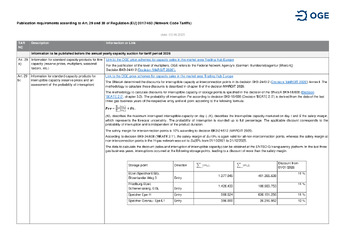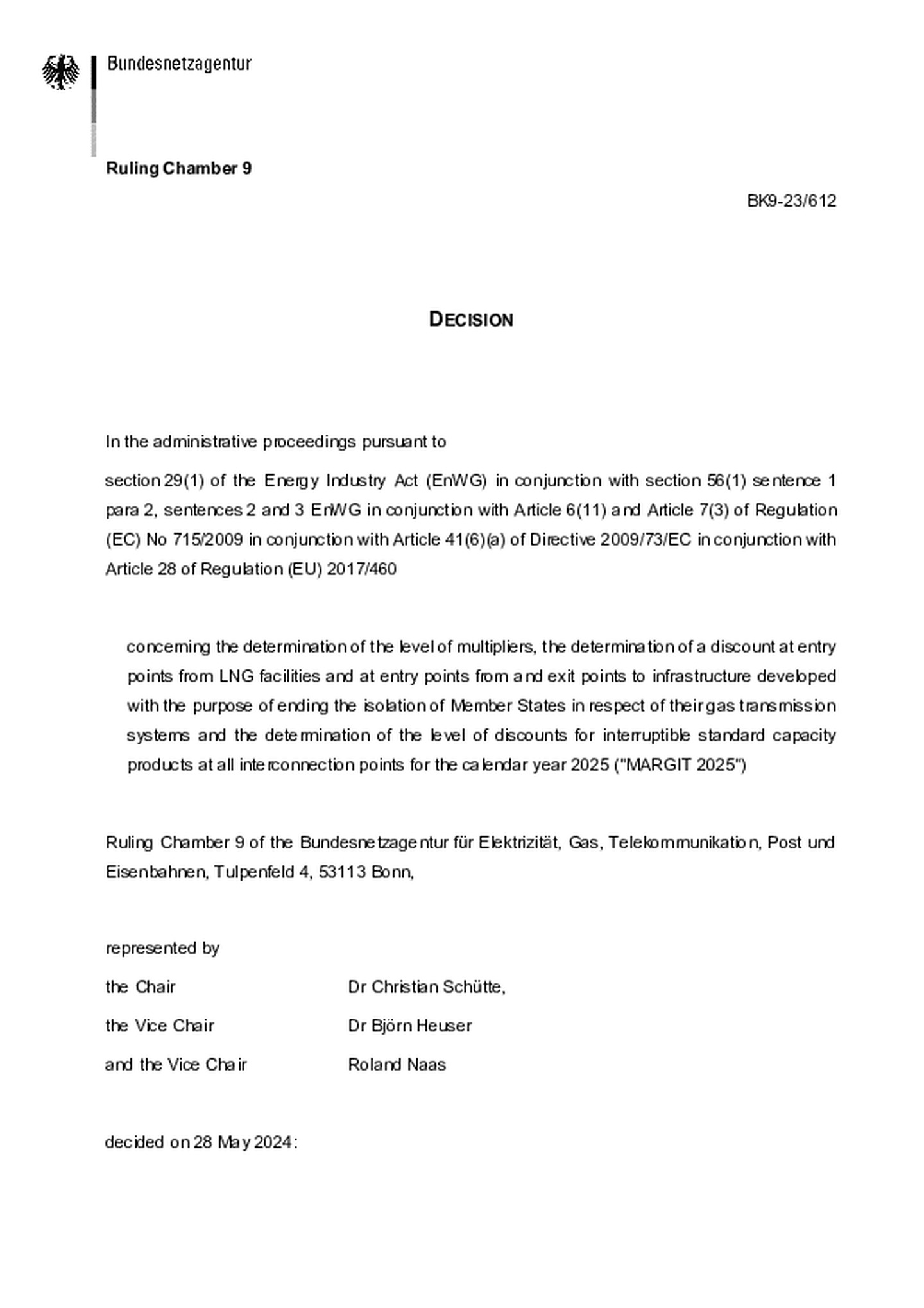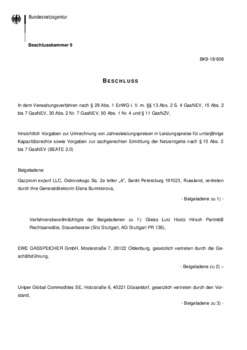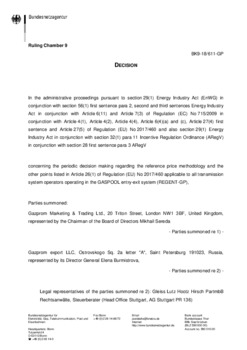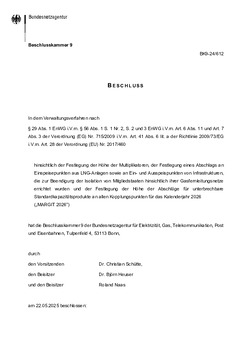
Publication
Information to be published before the annual yearly capacity auction and the tariff period
Publication by Open Grid Europe GmbH according to the network code on harmonised transmission tariff structures (Regulation (EU) 2017/460)
Information to be published before the annual yearly capacity auction for 2026
Art. 29 a)
Information for standard capacity products for firm capacity (reserve prices, multipliers, seasonal factors, etc.)
Link to the OGE price scheemes for capacity sales in the market area Trading Hub Europe
For the justification of the level of multipliers, OGE refers to the Federal Network Agency (German: Bundesnetzagentur [BNetzA]) Draft Decision BK9-24/612 (Decision ‘MARGIT 2026‘). MARGIT 2026 is currently only available in German language.
Art. 29 b)
Information for standard capacity products for interruptible capacity (reserve prices and an assessment of the probability of interruption)
Link to the OGE price scheemes for capacity sales in the market area Trading Hub Europe
The BNetzA determined the discounts for interruptible capacity at interconnection points in its draft decision BK9-24/612 (Decision ‘MARGIT 2026’) Annex I. The methodology to calculate these discounts is described in chapter 6 of the draft decision MARGIT 2026.
The data to calculate the discounts have been published during the consultation of decision MARGIT.
The methodology to calculate discounts for interruptible capacity of storage points is specified in the decision of the BNetzA BK9-18/608 (chapter 3.2). Further explanations on the determination of the probability of interruptions according to the decision BK9-18/608 (Decision ‘BEATE 2.0‘) can be found at the bottom of the page for download.
Information to be published before the next tariff period 2025
Art. 30 (1) a)
Information on parameters used in the applied reference price methodology related to the technical characteristics of the transmission system
All used input parameters (i.e. forecasted contracted capacity) are included in the simplified model
Art. 30 (1) a) ii)
forecasted contracted capacity at entry and exit points and associated points
Forecasted booked capacities at entry points in the market area of Trading Hub Europe: 144,550,707 kWh/h
Forecasted booked capacities at exit points in the market area of Trading Hub Europe: 329,441,161 kWh/h
Underlying capacity structure
Network fees are calculated on the basis of a forecast of the capacities booked in calendar year 2025 using the method described below, with a distinction being made between the following groups of handover points:
A) Border interconnection points as well as storage and network connection points:
The precise forecast of the booking quantities for each point and direction (including the distribution to the different capacity products and contract periods) was based on various input parameters (e.g. transport bookings and allocations of the last three years) using time series analyses and in consideration of current developments.
B) Virtual Interconnection Points (VIP)
The determination of the capacity forecast and the revenue distribution are based on the rules of Art. 22 NC TAR.
C) Internal orders:
The capacity framework for outgoing zones and interconnection points to downstream network operators is based on the internal orders for the calendar year 2024 available at OGE as of the reference date 13.05.2024, taking into account the long-term forecast with a submission date of 22.03.2024, as well as developments in the capacity requirements of the downstream network operators already known to OGE.
Art. 30 (1) a) iii)
the quantity and the direction of the gas flow for entry and exit points and associated assumptions, such as demand and supply scenarios for the gas flow under peak conditions
Art. 30 (1) a) iv)
the structural representation of the transmission network with an appropriate level of detail
Art. 30 (1) a) v)
technical information about the transmission network, such as the length and the diameter of pipelines and the power of compressor stations
Revenue cap forecast 2024 as included in tariffs (25.05.2023):
1,262,577,747€ in Trading Hub Europe market area
Revenue cap forecast 2025 as included in tariffs (24.05.2024):
1,192,201,749 € in Trading Hub Europe market area
Change:
-70.375.998 € in Trading Hub Europe market area Change in revenue cap (2025 vs. 2024) is mainly related due to lower volatile costs (in particular driving energy) as a result of the geopolitical situation and the impact on the European energy market.
Regulated asset base
3,808,177,141 € in Trading Hub Europe market area
Regulated asset base in cost base for the third regulatory period (base year 2020); does not include assets for investment measures according to § 23 Ordinance on Incentive Regulation (ARegV), which are approved for a period after 2022 and assets which are covered by the CCA according to § 10a ARegV
Incl. share of pipeline companies and leased pipelines.
Art. 30 (1) b) iii) (3)
a) methodologies to determine the initial value of assets
b) methodologies to re-evaluate the assets
c) explanations of the evolution of the value of the assets
d) depreciation periods and amounts per asset type
a) The capital expenditures are determined on the basis of the historical procurement and manufacturing costs of the asset as evaluated according to German Accounting Principles (HGB).
b) According to GasNEV, there is no re-evaluation of assets foreseen that are capitalized from 2006 onwards. Older Investments are partially considered at replacement values according to § 6a GasNEV.
c) There is a linear depreciation of the regulated asset base lied out in § 6 GasNEV
d) Depreciation period and values for asset types for existing assets valued in base year 2020:
I. General assets: 3-70 years (no depreciation for land); 28,611,359 €
II. Gas container: 45-55 years; 0 €
III. Compressor stations: 20-60 years; 51,858,065 €
IV. Pipelines: 30-65 years; 88,381,006 €
V. M+R stations: 8-60 years; 8,676,745 €
VI. Remote control systems: 15-20 years; 3,019,531 €
Sum: 180,546,706 €
Depreciation included in the cost base for the fourth regulatory period (base year 2020); does not include assets for investment measures according to § 23 Ordinance on Incentive Regulation (ARegV), which are approved for a period after 2022 and assets which are covered by the CCA according to § 10a ARegV.
Incl. share of pipeline companies and leased pipelines.
German transmission system operators are subject to the incentive regulation system. The revenue cap of a transmission system operator (TSO) that is determined for a regulatory period with a duration of 5 years is based on the costs incurred at the TSO in the base year (year 3 before the new regulatory period) and that were checked by the regulatory authority. Moreover, an efficiency benchmark is conducted between the TSO and, based on their cost and structure parameters, individual company efficiency values are calculated. Possible inefficiencies are to be rectified over the duration of a regulatory period. Furthermore, the regulatory authority calculates a general sector productivity factor that is consistently applied to all transmission system operators.
The general sector productivity factor for the third regulatory period is 0.49%. Since the BNetzA has not yet determined a final value for the fourth regulatory period, the general sector productivity factor from the third regulatory period was used initially.
The individual efficiency score of OGE is 100% for the fourth regulatory period.
Art. 30 (1) b) v)
the following ratios for the revenue referred to in point:
(1) capacity commodity split
(2) entry-exit split
(3) cross-border-domestic split
(1) OGE offers capacity-based tariffs only. Consequently, the share of capacity-based tariffs is 100%.
(2) Entry-Exit-Spilt
Market area Trading Hub Europe:
30.5 % Entry
69.5 % Exit
(3) Cross-border-domestic split in entry-exit system:
Market area Trading Hub Europe:
90.74 % domestic usage (2,885,900,580 €)
9.26 % cross-border usage (294,584,854€).
In conjunction with Art. 26 NC TAR consultation, the cost allocation test was carried out by the BNetzA. The test results, including an assessment, are published on the website of the Federal Network Agency via REGENT for the market area Trading Hub Europe (BK9-19/610) entry-exit system.
Art. 30 (1) b) vi)
Information related to the previous tariff period regarding the reconciliation of the regulatory account
(1) Actual regulated revenues obtained of 2023: 1,497,889,540 €
- thereof transmission service: 1.278,462,158 €
- thereof non-transmission service: 219,427,382 €
Aggregated balance of the regulatory account of the closed financial year 2023: 462,617,132 € (excess revenues)
Total balance of the regulatory account (net value) until 31.12.2023: 453,920,386 € (excess revenues)
(2) Reconciliation of the regulatory account for the concluded business year 2023 will be determined as of 31.12.2024 and it will be reconciled in equal instalments – including interest payments – over the three calendar years. The reconciliation begins the year after next after the application was submitted.
Incentive mechanisms specifically for the regulatory account do not exist in the German regulatory system.
Auction revenues are booked on the regulatory account in accordance with Article 5 ARegV. This transaction thus develops a tariff-reducing effect in the years in which the regulatory account is reconciled.
In accordance with the explanations of the BNetzA in the information paper for transmission system operators on the publication of tariffs in accordance with Art. 29, 31 and 32 of Regulation (EU) No. 2017/460 ("NC TAR") of 31.05.2024, the auction premium already achieved for the year 2025 that can be forecast on the basis of a best possible estimate, e.g. on the basis of reliable knowledge from previous annual auctions, are used to reduce the tariff.
Art. 30 (1) c)
Information on transmission and non-transmission tariffs accompanied by the relevant information related to their derivation
As part of the REGENT 2021 decision, the Federal Network Agency has decided the application of the reference price methodology postage stamp in the entry-exit system Trading Hub Europe. According to this, the transmission service revenues are to be divided by the forecasted contracted capacities of the entry and exit points of the calendar year.
Art. 30 (1) c) i)
where applied, commodity-based transmission tariffs referred to in Article 4 (3)
Art. 30 (1) c) ii)
where applied, non-transmission tariffs for non-transmission services referred to in Article 4 (4)
According to the decision of the FNA (BK9-17/609 (Festlegung ‘INKA’), the non-transmission services are set to metering point operation, metering service, biogas levy according to §20b GasNEV, market area conversion levy according to §19a Abs. 1 EnWG as well as the nomination replacement procedure according to §15 Abs. 3 GasNZV. The non-transmission service fees valid as of 01.01.2025 are published in the price sheets on the website of OGE.
Biogas levy calculaction
According to article 6 of the REGENT 2021 decision, the biogas levy is classified as a system service according to § 20b GasNEV. The calculation of the biogas levy is described there as well as in § 7 of the cooperation agreement between the operators of gas supply networks located in Germany from 22.03.2024. According to this, the nationwide total biogas costs of 2025 amounting to 303.1 million € are divided by the nationwide capacity booked or rather ordered from transmission system operators at network connection points to final consumers and grid connection points to downstream network operators, regardless of multipliers or seasonal factors of the year 2025, amounting to 287,526,485 (kWh/h)/a. This results in a biogas levy of 1.0542 €/(kWh/h)/a.
Market area conversion levy calculation
According to article 5 of the REGENT 2021 decision, the market area conversion levy is classified as a system service according to § 19a (1) EnWG. The calculation of the market area conversion charge is described there as well as in § 10 of the cooperation agreement between the operators of gas supply networks located in Germany from 22.03.2024. According to this, the nationwide conversion costs of the year 2025 amounting to 193.0 million € are divided by the nationwide capacity booked or rather ordered from transmission system operators at grid connection points to final consumers and grid connection points to downstream grid operators, regardless of multipliers or seasonal factors of the year 2025, amounting to 287,526,485 (kWh/h)/a. This results in a market conversion levy of 0.6713 €/(kWh/h)/a.
Calculation of fees for metering service and metering point operation
Fees for metering services and metering point operation are charged at the network connection points for which OGE assumes the relevant market roles. The fee for metering point operation includes the measurement. The fee for metering point operation is determined on the basis of a uniform fee for each bookable point plus a fee for each gas meter assigned to the bookable point. Consequently, the fee for metering point operation is calculated as follows:
Fee for metering point operation = fee for bookable point + (fee per gas meter x number of gas meters)
The fee per gas meter and the fee per bookable point are given in the appendix of the price sheet valid at 01.01.2025. The multipliers described for capacity booking with a run-time of less than 1 year do not apply to the fees for metering services and metering point operation.
Art. 30 (1) c) iii)
the reference prices and other prices applicable
at points other than those referred to in Article 29
The reference prices for exit points of internal orders and network connection points are the same as the postage stamp of the Trading Hub Europe market area. This corresponds to the tariff calculation method which the FNA has determined in the REGENT decision. The reference prices are the result of the sum of forecasted capacity bookings for all entry and exit points as well as the revenue cap and the entry/exit split of the calendar year t. The reference price and other prices can be taken from the current price sheet.
The postage stamp of the entry-exit system Trading Hub Europe will increase by 1.61 €/(kWh/h)/a in 2025 compared to the tariff in 2024. This change is based on regular fee adjustments taking into account changes of the input parameters allowed revenues and forecasts of contracted capacity of the transmission system operators involved. High storage levels, which are necessary for security of supply, and a significant decline in end consumption and transit volumes lead to a reduced booking forecast. Due to the regulatory account system, the extraordinary effects from the crisis year 2022 (e.g. declines in bookings and high fuel costs) are now increasing costs with a time lag for the first time in 2025. The diversification of supply sources by means of new LNG plants has supported security of supply and helped to dampen the gas price. The associated investments by individual transmission system operators in new entry points and connecting pipelines for the LNG facilities are now also included in the 2025 tariff calculation.
Art. 30 (2) a) ii)
The difference in the level of transmission tariffs for the same type of transmission service applicable for the tariff period for which the information is published and for each tariff period within the remainder of the regulatory period
In order to fulfil the publication requirements, the former approach of the BNetzA (Appendix 5 of REGENT 2021 decision) was continued to forecast the tariffs on an indicative basis. According to this, an increase in the charge would be expected in 2026.
It should be noted that the calculations depend on assumptions that are currently very difficult to forecast. Accordingly, the forecast should be interpreted as merely indicative to fulfil the publication requirements. For inflation, the values stated by the BNetzA in the information paper for transmission system operators on the publication of tariffs in accordance with Art. 29, 31 and 32 of Regulation (EU) No. 2017/460 ("NC TAR") of 31.05.2024 were used. Furthermore, an estimate was made for the general sectoral productivity factor according to Section 9 ARegV by updating the value from the third regulatory period, as the BNetzA has not yet determined a final value for the fourth regulatory period.
Further assumptions on the development of the forecast capacities and the annual development of the permissible revenues can be made directly by the user in the model.
Art. 30 (2) b)
Information about the used tariff model and an explanation how to calculate the transmission tariffs applicable for the prevailing tariff period
Art. 30 (3)
Information about the points excluded from the definition of relevant points
Downloads
Decision ‘MARGIT 2025‘ and
‘MARGIT 2026‘


Decision ‘BEATE 2.0‘
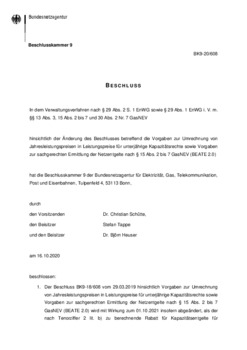
REGENT Rulings
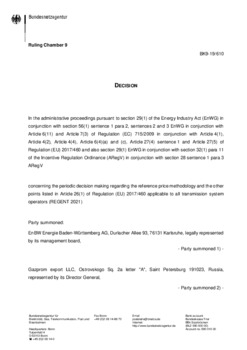
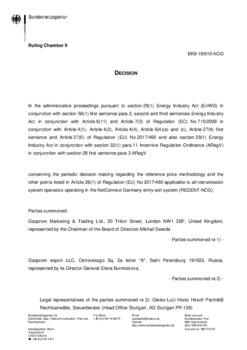
Others
